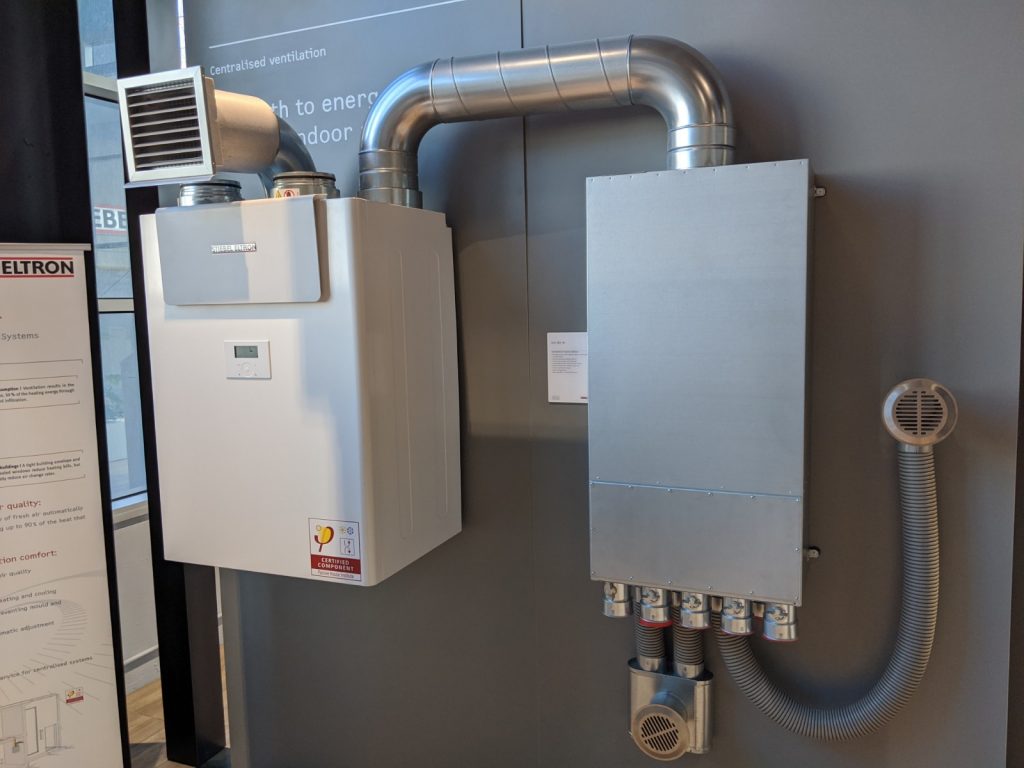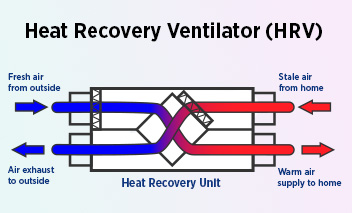The Environmental Impact of HRV in Modern Homes
Wiki Article
Revealing the Key Benefits and Uses of Heat Recovery Ventilation in Sustainable Layout
Heat Recovery Ventilation (HRV) systems play a necessary duty in sustainable design. They help with a continuous exchange of stagnant interior air with fresh exterior air, substantially improving indoor air quality. HRVs add to energy effectiveness by redeeming heat from exhausted air, which can reduce energy costs. Understanding the complex advantages and applications of HRVs exposes their significance in modern design. What other advantages do these systems provide in the pursuit of sustainability?Comprehending Heat Recovery Ventilation Equipments
Heat recovery ventilation (HRV) systems are developed to improve indoor air top quality while decreasing power loss. These systems use a mechanical ventilation approach to exchange stagnant interior air with fresh exterior air, ensuring a constant supply of tidy air. By recording warmth from the exhaust air, HRVs precondition inbound air, decreasing the demand on home heating and cooling systems. This procedure not just improves thermal convenience but likewise adds to power effectiveness in household and commercial buildings. Furthermore, HRV systems assist regulate humidity levels and minimize interior toxins, promoting a healthier living setting. Their critical implementation is important for accomplishing lasting layout goals, as they use an equilibrium in between power preservation and owner well-being.How HRV Solution Job
While lots of might know with air flow systems, recognizing just how warmth recuperation ventilation (HRV) systems run is essential for valuing their advantages. HRV systems work by exchanging stagnant interior air with fresh outside air while moving heat between the 2 streams. This process takes place in a heat exchanger, where warm from the outward bound air warms the inbound air throughout chillier months, decreasing power loss. On the other hand, in warmer months, the system can cool down inbound air utilizing the cooler outbound air. HRVs are geared up with followers to promote air movement and filters to get rid of particulates, ensuring a continuous, balanced air flow procedure. This ingenious design not just improves power performance yet also adds to keeping a comfortable interior atmosphere.Enhancing Indoor Air Quality
Interior air high quality can greatly impact wellness and wellness, making reliable air flow essential in modern-day homes. Heat Recovery Ventilation (HRV) systems play a necessary role in maintaining indoor air top quality by continually exchanging stagnant interior air with fresh outside air. This process not just decreases airborne contaminants but also minimizes moisture levels, which can bring about mold development and respiratory issues. HRV systems filter inbound air, removing irritants and particulates, thereby giving a healthier living setting. Furthermore, these systems help get rid of smells and volatile organic compounds (VOCs) generally found in family items. By guaranteeing a consistent flow of tidy air, HRV systems add to a total better indoor atmosphere, promoting comfort and wellness for owners.Energy Efficiency and Cost Cost Savings
Energy performance stands apart as a substantial benefit of Heat Recovery Ventilation (HRV) systems. By recording and reusing the heat from worn down indoor air, HRVs lessen the power needed for heating inbound fresh air, resulting in decreased power intake. This efficiency equates into lower utility expenses, supplying significant expense financial savings for property owners and services alike. Additionally, HRV systems typically certify for power performance motivations and rebates, further enhancing their economic appeal. Gradually, the preliminary investment in HRV modern technology can cause a favorable return on financial investment with lowered energy expenditures. Subsequently, the assimilation of HRV systems not just advertises sustainable style but likewise offers a sensible solution for achieving long-term power cost savings and monetary benefits.Environmental Benefits of HRV

A wide variety of environmental benefits occurs from the implementation of Heat Recovery Ventilation (HRV) systems. By efficiently moving warmth from exhaust air to inbound fresh air, HRVs significantly decrease the energy needed for home heating and cooling areas. This energy effectiveness translates to decrease greenhouse gas discharges, adding to a decrease in the total carbon impact of structures. Additionally, HRV systems boost interior air quality by continually distributing fresh air, thereby lowering the concentration of interior contaminants and irritants. Additionally, the reduction in power consumption help in preserving all-natural resources, making HRVs a necessary component of sustainable style. Overall, the ecological benefits of HRVs play a vital duty in advertising a much healthier planet and cultivating environment-friendly building techniques.
Versatile Applications in Modern Design
Heat recovery ventilation (HRV) systems are increasingly being incorporated right into both property and business architectural tasks. In domestic settings, HRVs improve interior air quality while making the most of energy performance. Meanwhile, in business spaces, these systems maximize ventilation strategies, showing their adaptability in modern-day building applications.Residential Projects Assimilation
While contemporary style significantly stresses sustainability, the assimilation of heat recovery ventilation systems in property tasks has actually emerged as a useful solution for enhancing indoor air high quality and energy effectiveness. These systems successfully move warm from exhaust air to inbound fresh air, lessening power loss and minimizing home heating or cooling down needs. In brand-new builds and retrofits alike, warm recuperation air flow can be perfectly integrated, providing homeowners with a much healthier living environment while lowering energy expenses. In addition, with enhancing recognition of ecological effects, more engineers and building contractors are identifying the long-lasting benefits of these systems. Because of this, warmth healing ventilation has come to be a vital part of lasting household style, showcasing versatility and dedication to green methods.Commercial Spaces Optimization
As modern business areas develop to satisfy the needs of sustainability and performance, the application of heat recovery air flow systems becomes a key strategy for optimizing interior atmospheres. These systems promote the exchange of stagnant interior air with fresh outside air while redeeming heat, significantly More Info lowering energy intake. This not just boosts convenience for passengers but also helps in reducing functional expenses. Versatile applications can be observed in offices, retail areas, and schools, where air high quality and temperature control are extremely important. In addition, incorporating heat healing ventilation straightens with green structure qualifications, additionally promoting environmental responsibility. Eventually, embracing such systems in business architecture not only adds to sustainability goals yet also promotes much healthier, more efficient rooms for users.
Integrating HRV Into Sustainable Style Practices
Incorporating warmth recuperation air flow (HRV) systems into sustainable design techniques uses considerable advantages in energy effectiveness and indoor air top quality. By utilizing HRV, developers can develop cost-efficient remedies that not just minimize power intake but also enhance the total convenience of indoor atmospheres. This alignment with sustainability objectives positions HRV as a necessary element in modern building methods.
Energy Efficiency Improvement
By integrating warm recuperation ventilation (HRV) systems right into lasting design practices, architects and building contractors can significantly enhance energy effectiveness in modern buildings. HRV systems operate by catching heat from outward bound stale air and transferring it to incoming fresh air, minimizing the power required for heating or cooling down indoor spaces. This procedure not only lowers reliance on traditional heating and cooling systems but likewise lowers total energy intake. In addition, HRV systems can aid preserve a regular indoor temperature, lowering peak energy needs. By integrating these systems, structures can accomplish substantial decreases in energy expenses and carbon footprints, straightening with sustainability goals. Inevitably, HRV innovation stands for a useful option for improving energy efficiency in the constructed atmosphere, advertising even more responsible resource use.Indoor Air Top Quality Renovation
Exactly how can warmth healing air flow (HRV) systems add to superior interior air quality in modern-day buildings? HRV systems effectively exchange stagnant indoor air with fresh outside air while recouping heat, reducing temperature changes. This process reduces the concentration of indoor contaminants, such as unstable organic substances (VOCs), irritants, and wetness, which can degrade air quality and impact occupant wellness. By preserving suitable humidity degrees and ensuring a continuous supply of tidy air, HRVs aid develop a healthier interior atmosphere. Furthermore, these systems can be integrated right into sustainable design methods, promoting energy performance alongside improved air top quality. HRV Heat Recovery Ventilation. HRV technology plays a vital duty in progressing general occupant convenience and wellness in contemporary building layouts.Cost-efficient Design Solutions

Often Asked Concerns
What Upkeep Is Required for Heat Recovery Ventilation Equipments?

Upkeep for warmth recovery air flow systems commonly includes normal filter replacements, cleansing of warmth exchangers, evaluation of followers and ducts, and ensuring appropriate drainage. These tasks assist keep effectiveness and extend the system's lifespan over time.
Can HRV Equipments Be Set Up in Existing Buildings?
Heat recovery ventilation systems can certainly be mounted in existing buildings. HRV Heat Recovery Ventilation. Retrofitting needs mindful preparation and evaluation of the building's layout, making sure compatibility with current systems while maximizing energy effectiveness and indoor air qualityHow Do HRV Solution Effect Sound Degrees Inside?
HRV systems can influence indoor sound degrees by presenting audio from outside resources through ventilation. High-grade setups often incorporate sound-dampening features, minimizing noise impact while providing efficient air exchange and maintaining comfort indoors.Exist Any Kind Of Downsides to Making Use Of HRV Systems?
The drawbacks of making use of HRV systems consist of prospective high first prices, upkeep difficulties, and the opportunity of minimized indoor air quality if filters are not routinely altered, which might lead to issues with moisture degrees.How Do I Pick the Right HRV System for My Needs?
Choosing the ideal warmth recovery air flow system entails evaluating specific needs, such as building dimension, environment, and energy effectiveness objectives. Furthermore, evaluating system features, installation requirements, and upkeep considerations is important for peak their explanation performance and satisfaction.Report this wiki page